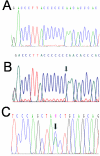Compound heterozygosity for a novel and a recurrent MFRP gene mutation in a family with the nanophthalmos-retinitis pigmentosa complex
- PMID: 19753314
- PMCID: PMC2742641
Compound heterozygosity for a novel and a recurrent MFRP gene mutation in a family with the nanophthalmos-retinitis pigmentosa complex
Abstract
Purpose: To report a new familial case of the recently described autosomal recessive syndrome of nanophthalmos-retinitis pigmentosa-foveoschisis-optic disc drusen, which arises from compound heterozygosity for Membrane Frizzled-Related Protein (MFRP) mutations in a sibling pair of Mexican origin.
Methods: Ophthalmological assessment included slit-lamp and dilated fundus examination, applanation tonometry, fundus photography, A-mode and B-mode ultrasound examination, electroretinogram, fluorescein retinal angiography, optical coherence tomography, and electrooculogram in both affected siblings. Molecular genetic analysis consisted of PCR amplification and direct automated sequence of the complete coding region of the MFRP gene. In addition, allele-specific cloning and sequencing techniques were used to characterize a heterozygous MFRP frameshift mutation.
Results: Clinical examination revealed high hyperopia of > +16 diopters while electroretinographic and fluorangiographic studies demonstrated a retinal dystrophy compatible with retinitis pigmentosa. Ultrasound examination showed nanophthalmos (eye axial length <15 mm) and optic disc drusen while optical coherence tomography evidenced cystoid macular edema. Nucleotide sequencing in DNA from both affected siblings disclosed the presence of two MFRP mutations: a novel heterozygous point mutation predicting a nonsense change from tyrosine (TAC) to a stop signal (TAA) at codon 317, and a heterozygous 1 bp deletion in exon 5, predicting a prematurely truncated protein (p.Asn167ThrfsX25).
Discussion: The third known family with the syndrome of nanophthalmos-retinitis pigmentosa-foveoschisis-optic disc drusen is presented. This is the first demonstration of compound heterozygosity for MFRP mutations as the source of the disease. The affected siblings described here are the youngest patients with the disease reported to date and the comparison of their clinical data with previous individuals with this syndrome suggest that some aspects of the phenotype are probably age-dependent.
Figures


Similar articles
-
A new autosomal recessive syndrome consisting of posterior microphthalmos, retinitis pigmentosa, foveoschisis, and optic disc drusen is caused by a MFRP gene mutation.Mol Vis. 2006 Dec 4;12:1483-9. Mol Vis. 2006. PMID: 17167404
-
A novel crumbs homolog 1 mutation in a family with retinitis pigmentosa, nanophthalmos, and optic disc drusen.Mol Vis. 2012;18:2447-53. Epub 2012 Oct 4. Mol Vis. 2012. PMID: 23077403 Free PMC article.
-
A novel mutation confirms MFRP as the gene causing the syndrome of nanophthalmos-renititis pigmentosa-foveoschisis-optic disk drusen.Am J Ophthalmol. 2008 Aug;146(2):323-328. doi: 10.1016/j.ajo.2008.04.029. Epub 2008 Jun 13. Am J Ophthalmol. 2008. PMID: 18554571
-
MFRP variant results in nanophthalmos, retinitis pigmentosa, variability in foveal avascular zone.Ophthalmic Genet. 2023 Feb;44(1):83-88. doi: 10.1080/13816810.2022.2103835. Epub 2022 Jul 26. Ophthalmic Genet. 2023. PMID: 35880649 Review.
-
A novel frameshift variant in CEP78 associated with nonsyndromic retinitis pigmentosa, and a review of CEP78-related phenotypes.Ophthalmic Genet. 2022 Apr;43(2):152-158. doi: 10.1080/13816810.2022.2045511. Epub 2022 Mar 3. Ophthalmic Genet. 2022. PMID: 35240912 Review.
Cited by
-
Novel compound heterozygous mutations in the MFRP gene in a Japanese patient with posterior microphthalmos.Jpn J Ophthalmol. 2012 Jul;56(4):396-400. doi: 10.1007/s10384-012-0145-4. Epub 2012 May 9. Jpn J Ophthalmol. 2012. PMID: 22565643
-
Missense Mutations in the Human Nanophthalmos Gene TMEM98 Cause Retinal Defects in the Mouse.Invest Ophthalmol Vis Sci. 2019 Jul 1;60(8):2875-2887. doi: 10.1167/iovs.18-25954. Invest Ophthalmol Vis Sci. 2019. PMID: 31266059 Free PMC article.
-
Membrane frizzled-related protein gene-related ophthalmological syndrome: 30-month follow-up of a sporadic case and review of genotype-phenotype correlation in the literature.Mol Vis. 2012;18:2623-32. Epub 2012 Oct 26. Mol Vis. 2012. PMID: 23112574 Free PMC article.
-
Identification of novel pathogenic variants and novel gene-phenotype correlations in Mexican subjects with microphthalmia and/or anophthalmia by next-generation sequencing.J Hum Genet. 2018 Nov;63(11):1169-1180. doi: 10.1038/s10038-018-0504-1. Epub 2018 Sep 4. J Hum Genet. 2018. PMID: 30181649
-
Optic cup morphogenesis across species and related inborn human eye defects.Development. 2023 Jan 15;150(2):dev200399. doi: 10.1242/dev.200399. Epub 2023 Jan 30. Development. 2023. PMID: 36714981 Free PMC article. Review.
References
-
- Ayala-Ramirez R, Graue-Wiechers F, Robredo V, Amato-Almanza M, Horta-Diez I, Zenteno JC. A new autosomal recessive syndrome consisting of posterior microphthalmos, retinitis pigmentosa, foveoschisis, and optic disc drusen is caused by a MFRP gene mutation. Mol Vis. 2006;12:1483–9. - PubMed
-
- Crespí J, Buil JA, Bassaganyas F, Vela-Segarra JI, Díaz-Cascajosa J, Ayala-Ramírez R, Zenteno JC. A novel mutation confirms MFRP as the gene causing the syndrome of nanophthalmos-renititis pigmentosa-foveoschisis-optic disk drusen. Am J Ophthalmol. 2008;146:323–8. - PubMed
-
- Katoh M. Molecular cloning and characterization of MFRP, a novel gene encoding a membrane-type Frizzled-related protein. Biochem Biophys Res Commun. 2001;282:116–23. - PubMed
-
- Fuchs J, Holm K, Vilhelmsen K, Rosenberg T, Scherfig E, Fledelius HC. Hereditary high hypermetropia in the Faroe Islands. Ophthalmic Genet. 2005;26:9–15. - PubMed
Publication types
MeSH terms
Substances
LinkOut - more resources
Full Text Sources
